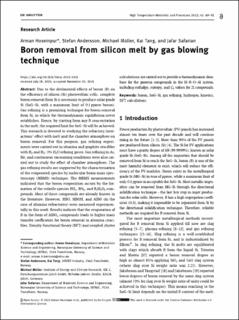| dc.contributor.author | Hoseinpur Kermani, Arman | |
| dc.contributor.author | Andersson, Stefan | |
| dc.contributor.author | Müller, Michael | |
| dc.contributor.author | Tang, Kai | |
| dc.contributor.author | Safarian, Jafar | |
| dc.date.accessioned | 2022-08-05T09:10:00Z | |
| dc.date.available | 2022-08-05T09:10:00Z | |
| dc.date.created | 2021-12-19T21:23:54Z | |
| dc.date.issued | 2022 | |
| dc.identifier.citation | High Temperature Materials and Processes. 2022, 41 (1), 69-91. | en_US |
| dc.identifier.issn | 0334-6455 | |
| dc.identifier.uri | https://hdl.handle.net/11250/3010292 | |
| dc.description.abstract | Due to the detrimental effects of boron (B) on the efficiency of silicon (Si) photovoltaic cells, complete boron removal from Si is necessary to produce solar grade Si (SoG–Si, with a maximum limit of 0.1 ppmw boron). Gas refining is a promising technique for boron removal from Si, in which the thermodynamic equilibrium never establishes. Hence, by starting from any B concentration in the melt, the required limit for SoG–Si will be achieved. This research is devoted to studying the refractory interactions’ effect with melt and the chamber atmosphere on boron removal. For this purpose, gas refining experiments were carried out in alumina and graphite crucibles with H2 and H2–3% H2O refining gases. Gas refining in Ar, He, and continuous vacuuming conditions were also carried out to study the effect of chamber atmosphere. The gas refining results are supported by the characterization of the evaporated species by molecular beam mass spectroscopy (MBMS) technique. The MBMS measurements indicated that the boron evaporation occurs by the formation of the volatile species BH x , BO y , and B z H x O y compounds. Most of these compounds are already known in the literature. However, HBO, HBOH, and AlBO (in the case of alumina refractories) were measured experimentally in this work. Results indicate that the evaporation of B in the form of AlBO x compounds leads to higher mass transfer coefficients for boron removal in alumina crucibles. Density-functional theory (DFT) and coupled cluster calculations are carried out to provide a thermodynamic database for the gaseous compounds in the H–B–O–Al system, including enthalpy, entropy, and C P values for 21 compounds. | en_US |
| dc.language.iso | eng | en_US |
| dc.publisher | De Gruyter | en_US |
| dc.rights | Navngivelse 4.0 Internasjonal | * |
| dc.rights.uri | http://creativecommons.org/licenses/by/4.0/deed.no | * |
| dc.subject | DFT calculations | en_US |
| dc.subject | kinetics | en_US |
| dc.subject | hydrogen | en_US |
| dc.subject | gas refining | en_US |
| dc.subject | SoG–Si | en_US |
| dc.subject | boron | en_US |
| dc.title | Boron Removal from Silicon Melt by gas Blowing Technique | en_US |
| dc.title.alternative | Boron Removal from Silicon Melt by gas Blowing Technique | en_US |
| dc.type | Peer reviewed | en_US |
| dc.type | Journal article | en_US |
| dc.description.version | publishedVersion | en_US |
| dc.rights.holder | © 2022 Arman Hoseinpur et al., published by De Gruyter | en_US |
| dc.source.pagenumber | 69-91 | en_US |
| dc.source.volume | 41 | en_US |
| dc.source.journal | High Temperature Materials and Processes | en_US |
| dc.source.issue | 1 | en_US |
| dc.identifier.doi | 10.1515/htmp-2022-0011 | |
| dc.identifier.cristin | 1970311 | |
| cristin.ispublished | true | |
| cristin.fulltext | original | |
| cristin.qualitycode | 1 | |

